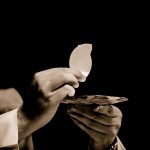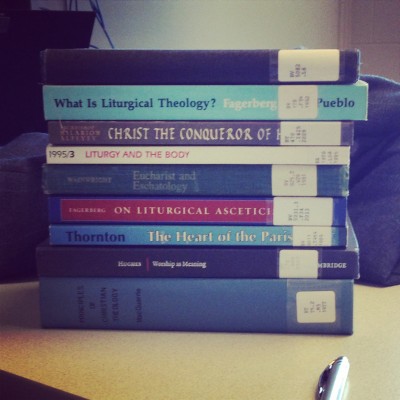Thesis
What does it mean to abide in Jesus? It’s a beautiful word but too often we miss out on any substantive definition or depiction. The RCL lessons for Easter 5 provide some concrete portrayals of this concept: trust, obedience, proclamation and a sort of “knowing” that moves beyond cognition and into something deeper. Prepare yourselves because Easter 5 and 6 will both feature gospel lessons from John 15.
Analysis
Collect
Almighty God, whom truly to know is everlasting life: Grant us so perfectly to know your Son Jesus Christ to be the way, the truth, and the life, that we may steadfastly follow his steps in the way that leads to eternal life; through Jesus Christ your Son our Lord, who lives and reigns with you, in the unity of the Holy Spirit, one God, for ever and ever. Amen.
This is another situation when the Collect and the Gospel lesson seem to miss each other by a small margin. Upon first reading of the Collect one would assume that John 14 is the appointed text given the reference to “the way, the truth, and the life.” However, the Gospel lesson appointed for Year B is John 15:1-8 where Jesus talks about abiding in him and his relationship with the Father. There is a connection to John 14 and although it is simple it is also overlooked: John 14-17 constitutes the “Upper Room Discourse” from which we get Jesus’ High Priestly Prayer. The final “I Am” statement of John’s Gospel should not be separated from his words about abiding or from his priestly intercessions.
To abide in Christ is to know him as the way, the truth and the life. To know him ‘perfectly’ is to abide in his love just as he abides in the love of his Father. To follow him (think to last week about the Good Shepherd) requires a trusting obedience and foundation of “knowing” that moves beyond mental assent. It is a knowledge that is based in love and based on faith. Jesus is the life and therefore to know him is to have life, both now and evermore.
First Lesson – Acts 8:26-40
The Lectionary gives us another opportunity to discover Philip’s apostolic witness. It was on the Fifth Sunday in Lent that we last encountered Philip. Philip was then approached by some Greeks (read: Gentiles) who desired to see Jesus. Philip and Nathanael took the Greeks to Jesus in a move that reminded the reader of Philip’s “Come and see” comment to Nathanael after encountering Jesus at the beginning of John’s Gospel. The two Philipian stories serve as bookends on the “Book of Signs in John and now we are again reading of Philip’s ministry among the Gentiles.
Here Philip encounters a god-fearing Ethiopian Eunuch who has been worshipping in Jerusalem and is now traveling home. It is important to note that the Holy Spirit leads Philip to the man. The Spirit that drove Jesus into the wilderness is the same Spirit that urges Philip to the Wilderness Road and to engage the Ethiopian Eunuch. Philip is an example to us all in that his ministry is not complex or complicated; in fact, it is actually quite simple: obedience and gospel proclamation. In this story we see that Philip is both obedient to the urging of the Holy Spirit and that he proclaims the Good News of Jesus to the Eunuch and to those in Azotus.
The Ethiopian Eunuch is reading from Isaiah and cannot understand the words on the page. Think about the lessons from last Sunday and how Jesus had to open the minds of his disciples to understand the Scriptures. Philip makes himself present to the man and asks him plainly, “Do you understand what you are reading?” Philip then takes the opportunity to explain the Scriptures to the Ethiopian and he does so through the lens of Jesus; just as Jesus explained the meaning of the Scriptures to the companions on the Road to Emmaus and how they were fulfilled in him, so too does Philip present Jesus as the fulfillment of Isaiah, the law and the prophets.
What is the proper response to Gospel? It is conversion and initiation! The Eunuch is baptized on the spot after hearing the Gospel. Baptism is an extremely important event in the life of an individual and in the life of the church; it is one of the two dominical sacraments and it is initiation into the family of God. It should not be entered into carelessly but it also should not be withheld until someone reaches a certain level of spiritual knowledge or maturity. The Eunuch was baptized in the name of the Father, and of the Son, and of the Holy Spirit because clearly he believed that Isaiah foretold of Jesus who was both crucified and risen. There would be time after ‘conversion’ for mystagogy, discipleship or “membership classes.”
Psalm 22:24-30
What a difference a month makes! It was just one month ago that we were reading this Psalm but in a much different context. Psalm 22 came up on Good Friday and I wrote about it here in relation to Jesus’ words on the cross.
Just to recap, verses 24-30 form the movement of the Psalm from lament to praise. The Psalmist and those proclaiming the Psalm in the holy gathering are able to place their trust in YHWH because he is faithful. The Psalmist has these things to say about YHWH:
Kingship belongs to God, he rules over all nations
He alone is worthy of all worship, all bow to him
He has performed saving deeds
The Psalmist can therefore move from “my God why have you forsaken me?” to “My soul shall live for him!” based on one reason: God’s covenant love is steadfast and he has revealed himself as faithful time and time again. Even in the midst of lament there can still be praise!
Epistle – 1 John 4:7-21
I have made several comments in recent weeks about the apparent disconnect between the RCL lessons for Year B and the appointed Collects. That being said, I have been extremely pleased with the Eastertide Year B pairings of John’s epistle and his gospel. 1 John 4 matches very nicely with John 15 as they both stay focused on one topic: abiding. Even better, John gives us another word for our working definition: love.
To abide is to love and to remain in God’s love. The basis for all such love is the love of God that is first, it is sufficient and it is complete. God loves us and therefore we should love one another. God so loved the world that he sent his son to be the sacrifice for our sins; therefore we should love each other.
The contact points with John’s gospel are amazing. 1 John 4:9-10 matches up with John 3:16-17; 1 John 4:16b is John 15; 1 John 4:21 is John 13 with the new commandment. The possibilities for overlapping and interrelation are endless but one point is clear: we are called to radical love of God and neighbor because God loves us radically.
There is a big difference between “the fear of the LORD” as seen throughout the Old Testament and the concept of fearing God. The fear of the LORD is a phrase that is used to convey the awesome and awful-ness (original meaning) of God. Almighty God is awe-inspiring and therefore we should have a healthy reverence for his might and power. That being said, he has drawn close to us and has revealed himself in both testaments as loving and as good. It’s like that famous scene in The Lion, the Witch, and the Wardrobe: the children are with the beavers and are eventually told that Aslan isn’t safe, but he’s good. We can draw near to the throne of grace because the Lord has conquered all by trampling down death by death and has beckoned us. He loves us and now we too can love him.
Gospel – John 15:1-8
As mentioned in the ‘thesis’ section, John 15 is part of the Upper Room Discourse and it precedes Jesus’ High Priestly Prayer. Jesus has shared a meal with his disciples, he has washed their feet, and he has declared himself to be “the way, the truth, and the life” and that “no one comes to the Father but through me.”
We now enter into a lengthy section with the analogy of vine, vinedresser and branch. I have already made reference to my friend, Margaret Feinberg, in my sermon notes for Easter 4, but I commend her book to you again. Margaret spent time with a shepherdess, a vintner, a farmer, and a beekeeper in order to unlock some of the lost meanings of biblical imagery. Much of the western world is no longer agrarian and so certain references that were normal for 1st century Israel are lost on us. Pick up a copy of Scouting the Divine for Easter 5 and 6 to read about vines and branches.
The analogy is simple: Jesus is the vine, the Father is the vinedresser, and we are the branches. Branches that bear no fruit are removed. Branches that bear fruit are pruned. Why would you prune a fruitful branch? By removing the branches that have no fruit you are able to give more nutrients to those that do and by pruning the fruitful branches you are helping them to grow stronger. I have a Forsythia bush and several Lilac bushes in my backyard and I have been told to prune them by up to one-third after the first bloom of the year. In gardening ventures one cannot win through preacher’s math! You have to cut to grow. Plants are able to devote more healing, sustaining and growing attention to areas that have suffered intentional cuts.
How do we abide? Well, it’s a two-way street as Jesus abides in us. Jesus’ words are to live in us and we can then live in him. In fact, we can do nothing apart from Jesus! Have you ever heard someone say, “I love Jesus but not the church. I’m just going to do “church” on my own,”? Church cannot be down alone or apart from Jesus because it is the body of Christ. You cannot have the church without Jesus. Through obedience, and love, and action we are able to abide in the vine and therefore in the Father as well. Link John 15 with 1 John 4 for a robust image.
Liturgical Considerations
Consider using the Apostles’ Creed this Sunday instead of the Nicene Creed if you plan on highlighting the baptismal scene in Acts 8. The Apostles’ Creed is the baptismal statement of faith of the Church and can/should be used on Sundays when there are baptisms or when we reaffirm our baptismal vows. I’d encourage you to have baptisms on this Sunday if you have any in the pipeline and/or weren’t able to baptize during Easter/Easter Vigil. Baptism is certainly a way of “abiding” in Jesus.
The other liturgical element on offer is the Eucharist. In the Rite of Baptism we see individuals initiated into the family of God and in the Holy Eucharist we see the church become that which she already is and we are all nourished in the Body and Blood of Jesus. In short, the Eucharist is a tangible example of the Lord’s invitation to abide.
The combination of baptism and Eucharist—and the two should never be separated—would be a robust example of knowing and following Jesus.
Here is the baptismal liturgy from the 1979 Book of Common Prayer
Here is the baptismal liturgy from the 1928 Book of Common Prayer
Synthesis
To abide in Jesus is to love him and to know him to be the way, the truth, and the life. To abide is to have the abundant life promised by Jesus and to have it now. Jesus said that the world would know we are his disciples by our love for one another.
We see Philip abiding in Jesus through his obedience to the Holy Spirit and his proclamation of the gospel. We see the Psalmist abiding in YHWH through his praise even in the midst of tribulation. We see John calling us to abide in Jesus through love in his epistle. We see Jesus calling us to abide in him through keeping his words.
We are invited into an abiding relationship through our baptism and through regular participation in the Eucharist. May your sermon be an invitation into such a relationship and may it be life giving, even if you have to offer some pruning along the way.











